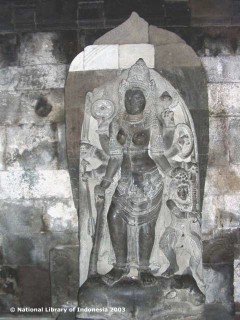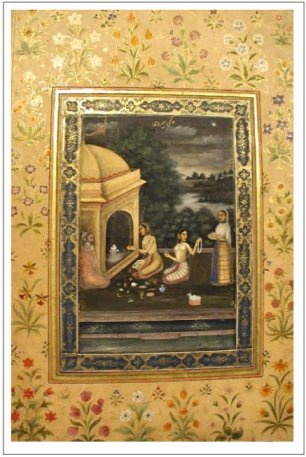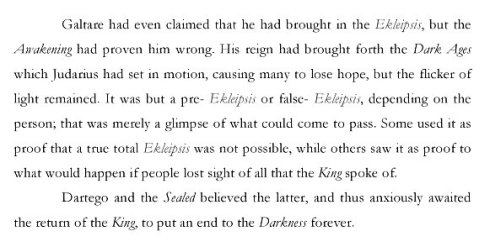BHAIRAVI
“The Ferocious One Who Calls to Heroism,”
attended by Dhumavati, “The Widowed Hag”
.
.
FROM THE BHAIRAVI ECLIPSE
.
1.
a. The partial or complete obscuring, relative to a designated observer, of one celestial body by another.
b. The period of time during which such an obscuration occurs.
2. A temporary or permanent dimming or cutting off of light.
3.
a. A fall into obscurity or disuse; a decline: “A composer . . . often goes into eclipse after his death and never regains popularity” (Time).
b. A disgraceful or humiliating end; a downfall: Revelations of wrongdoing helped bring about the eclipse of the governor’s career.
tr.v. e·clipsed, e·clips·ing, e·clips·es
1.
a. To cause an eclipse of.
b. To obscure; darken.
2.
a. To obscure or diminish in importance, fame, or reputation.
b. To surpass; outshine: an outstanding performance that eclipsed the previous record.
[Middle English, from Old French, from Latin eclpsis, from Greek ekleipsis, from ekleipein, to fail to appear, suffer an eclipse : ek-, out; see ecto- + leipein, to leave; see leikw- in Indo-European roots.]
Etymology
From Latin eclīpsis, from Ancient Greek ἔκλειψις (ekleipsis, “eclipse”), from ἐκλείπω (ekleipō, “I abandon”), from ἐκ (ek, “out”) and λείπω (leipō, “I leave behind”)
.
.
BHAIRAVI
Sie gehört in der indischen Mythologie zu den 10 großen Göttinen, den Dasa Mahavidyas Die Darstellung zeigt sie auf einem Tiger reitend. Sie trägt ein rotes Kleid.(Blut) und trägt eine Girlande aus abgeschlagenen Köpfen.In den Händen ihrer 4 Armpaare hält sie Gegenstände:
Schild und Muschel, weißes Schwert und Bogen, Szepter und Dreizack, die rechte, unterste Hand formt eine Mudra und die zugehörige Linke hält einen Lotus. Die Reihenfolge variiert auf den Darstellungen. Sie ist von weißem Licht umgeben, dies zeigt den intellektuellem Aspekt, sie muß vom goldenen Licht erlöst werden, der emotionale Aspekt.In ihrem Mythos hatte der Büffeldämon Mahisa, König der Gegengötter in einem langen Krieg, 3 göttliche Armeen besiegt und vertrieb die Götter aus dem Himmel.Die Götter wanderten heimatlos über die Erde. Geführt von Shiva und Vishnu konzentrierten sie ihre Kräfte auf die Erscheinung von Bhairavi. Die Kraft von Shiva formte ihren Kopf, die von Yama ihr Haar, Vishnu ihre Arme, Indra ihre Taille. Alle Gottheiten übergaben ihr ihre Waffen. Sie wählte den Tiger/Löwen als ihr Reittier. In langen Schlachten besiegte sie die Gegengottheiten und am Ende deren König Mahisha, in Form eines Büffels, nachdem sie ihn in vielen Erscheinungen bekämpft hatte..Sie besiegt ihn, schlägt ihm den Kopf ab und heißt danach Durga Mahisasura-Mardini, die Schlächterin des Mahisasura. Danach konnten die Götter wieder in den Himmel einziehen.

Sie wird durch die fünf M verehrt
Madya-Wein ekstatische Trunksucht
Matsya-Fisch du bist die Seele die in Paramatma schwimmt
Mamsa-Selbstaufopferung
Mudra-Symbolgesten
Maithuna-Vereinigung

Sie transformiert Schönheit in Alter, Wissen in Weisheit. Anders formuliert, die Göttin der Weisheit und des Verfalls.
Ihr Mantra lautet : Om Bhairavi Saham. Zu ihr gehört das Muladhara-Chakra
.
.
BHAIRAVI ii
Bhairavi is a fierce and terrifying aspect of the Devi virtually indistinguishable from Kali, except for her particular identification as the consort of the Bhairava.
She is also called Shubhamkari, good mother to good people and terrible to bad ones. She is seen holding book, rosary, and making fear-dispelling and boon-conferring gestures. She is also known as Baala or Tripurabhairavi. It is believed that when Bhairavi entered the battle field, her horrible appearance made the demons become weak and very feeble, and it is also believed that most of the demons started panicking as soon as they saw her. The consort of Goddess Bhairavi is Bhairava an aspect of Shiva.
Bhairavi is seen mainly as the Chandi in the Durga Saptashati version of slaying Shumbha and Nishumbha. However, she kills and drinks the blood of Chanda and Munda the Chieftains of asuras, so the Goddess Parvati gives her a boon that she would be called Chamundeshwari. In other forms, she is also identified with Parvati or Durga. When furious, she is found sitting on a faithful donkey, with her mouth full of demons’ blood, her body covered with a tiger skin and skeleton. She also presents the abhaya mudra and vara mudhra, and she is shown holding weapons such as a trident, axe, and thunderbolt.
Bhairavi is also a title for a female adept in Kundalini Tantra. A Yogini is a student of Tantra, or an aspirent. A Bhairavi is one who has succeeded. Supposedly there are many more levels of achievement than these two, but Tantra is, in essence, a mystery religion, and one would have to be initiated, to learn them all. The name “Bhairavi” means “Terror,” or “awe-inspiring,” so the one who has achieved the state of Bhairavi, is beyond the fear of death, and therefore awesome.
Many South Indian Temples are dedicated to Bhairavi as Baala Tripura Devi. One of the famous shrines of her is in Jagannath Temple, Puri as Vimala. The Vimala temple is also known as a Bhairavi temple. In Brahmayamala Tantra Vimala is regarded as the Shakti of Purusottama Kshetra.
.






You must be logged in to post a comment.